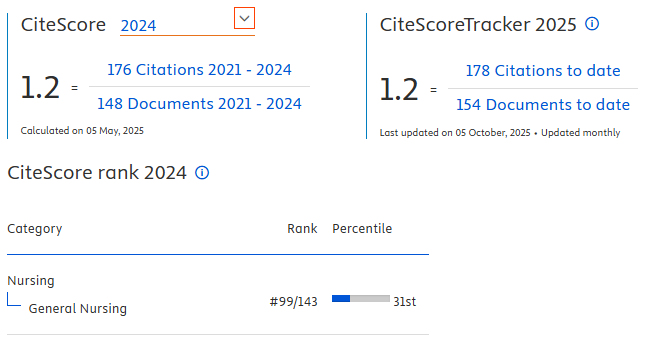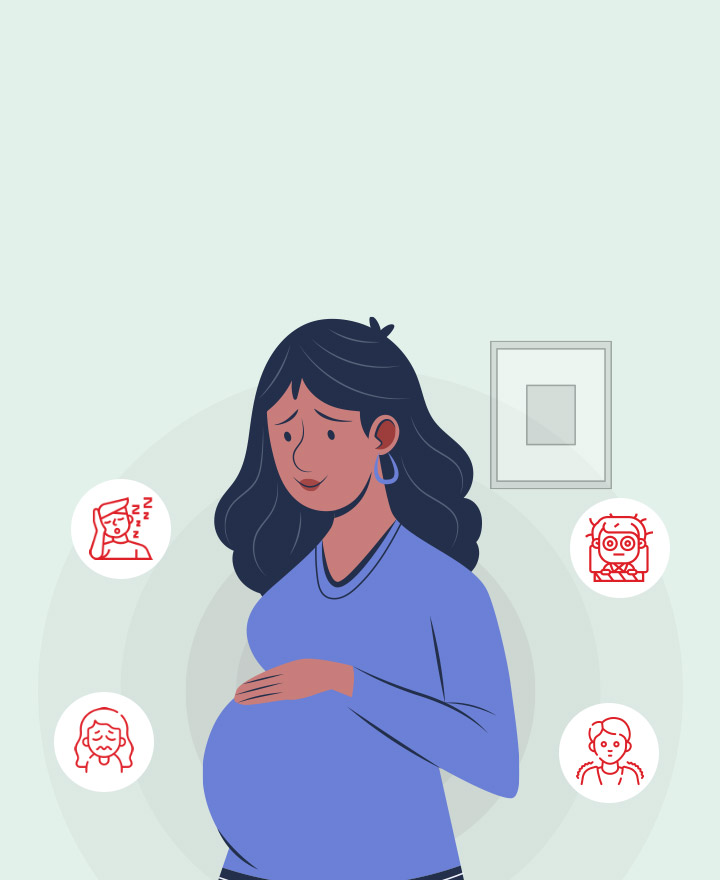Analysis of Sociodemographic and Information Factors on Family Behaviour in Early Detection of High-Risk Pregnancy
Downloads
Introduction: Pregnancy and childbirth are physiological processes experienced by women, but they sometimes have risky conditions. There are still many pregnant women and their families who are unable to detect a high-risk of pregnancy early. This study aims to determine family behaviour in conducting early detection of a high-risk of pregnancy in terms of sociodemographic and information factors.
Methods: This study uses an explanatory survey design with a cross sectional design. The sample size of this study was 146, with simple random sampling. The independent variables were sociodemographic factors (age, gender, ethnicity, education, income and religion) and information factors (experience, and media exposure) while the dependent variable is family behaviour. The instrument with the questionnaire used the Likert scale. The data was analysed using partial least square.
Results: The results showed that Structural Equation Modelling-Partial least square (SEM-PLS) statistical analysis, through Confirmatory Factor Analysis (CFA), obtained sociodemographic factors on family behaviour of 1,999, and information factors on family behaviour of 13,78. The value of the influence of sociodemographic factors (0.102) and the value of the influence of information factors (0.754). R2 (0.63) and Q2 value of 0.65.
Conclusion: Sociodemographic factors and information factors significantly influenced family behaviour factors in early detection of high-risk of pregnancy. Information factors have a greater effect on family behaviour than sociodemographic factors. Midwives as health service providers at the health care centre need to optimize family empowerment through health information efforts in health promotion efforts. Further research requires the involvement of other factors to improve family behaviour, especially in the ability of families to detect early high-risk pregnancies.
Abdollahpour, S., Ramezani, S., & Khosravi, A. (2015). Perceived social support among family in pregnant women. International Journal of Pediatrics. https://doi.org/10.22038/ijp.2015.4703
Alemayehu, M., & Meskele, M. (2017). Health care decision making autonomy of women from rural districts of Southern Ethiopia: A community based cross-sectional study. International Journal of Women's Health. https://doi.org/10.2147/IJWH.S131139
Asmuji., & Indriyani, D. (2016). Model Family Centered Maternity Care sebagai strategi Optimalisasi Competent Mothering. Ners Airlangga. https://doi.org/http://dx.doi.org/10.20473/jn.V11I12016.17-28
Azwar, S. (2013). Sikap Manusia: Teori dan Pengukurannya. Sikap Manusia: Teori Dan Pengukurannya. https://doi.org/10.1038/cddis.2011.1
Baron, R., Heesterbeek, Q., Mannií«n, J., Hutton, E. K., Brug, J., & Westerman, M. J. (2017). Exploring health education with midwives, as perceived by pregnant women in primary care: A qualitative study in the Netherlands. Midwifery. https://doi.org/10.1016/j.midw.2017.01.012
Biaggi, A., Conroy, S., Pawlby, S., & Pariante, C. M. (2016). Identifying the women at risk of antenatal anxiety and depression: A systematic review. Journal of Affective Disorders. https://doi.org/10.1016/j.jad.2015.11.014
Budiati, T., & Setyowati. (2019). The influence culture and maternal care on exclusive breastfeeding practice in post caesarean section mothers. Enfermeria Clinica. https://doi.org/10.1016/j.enfcli.2019.04.121
Chimowitz, H., Gerard, M., Fossa, A., Bourgeois, F., & Bell, S. K. (2018). Empowering Informal Caregivers with Health Information: OpenNotes as a Safety Strategy. Joint Commission Journal on Quality and Patient Safety. https://doi.org/10.1016/j.jcjq.2017.09.004
Chou, J. L., Pierce, K. J., Pennington, L. B., Seiler, R., Michael, J., Mc Namara, D., & Zand, D. (2018). Social Support, Family Empowerment, Substance Use, and Perceived Parenting Competency during Pregnancy for Women with Substance Use Disorders. Substance Use and Misuse. https://doi.org/10.1080/10826084.2018.1467456
Dewi, R. G. A. I. (2017). Pengaruh Kemampuan Ibu Hamil Dalam Melakukan Deteksi Dini Risiko Preeklamsia Terhadap Paritas, Pengetahuan Dan Keterpaparan Informasi. Medical Technology and Public Health Journal. https://doi.org/10.33086/mtphj.v1i1.275
Diana, R., Rachmayanti, R. D., Anwar, F., Khomsan, A., Christianti, D. F., & Kusuma, R. (2018). Food taboos and suggestions among Madurese pregnant women: a qualitative study. Journal of Ethnic Foods. https://doi.org/10.1016/j.jef.2018.10.006
Fatkhiyah, N., Kodijah, K., & Masturoh, M. (2018). Determinan Maternal Kejadian Preeklampsia: Studi Kasus di kabupaten Tegal, Jawa Tengah. Jurnal Keperawatan Soedirman. https://doi.org/10.20884/1.jks.2016.11.1.642
Health Office of East Java Province. (2017). Profil Kesehatan Jawa Timur 2017. In Profil Kesehatan Jawa Timur.
Health Office of Surabaya. (2017). Profil Dinas Kesehatan Kota Surabaya. In Dinas Kesehatan.
Holness, N. (2018). High-Risk Pregnancy. Nursing Clinics of North America. https://doi.org/10.1016/j.cnur.2018.01.010
Huang, X., Dai, S., & Xu, H. (2020). Predicting tourists' health risk preventative behaviour and travelling satisfaction in Tibet: Combining the theory of planned behaviour and health belief model. Tourism Management Perspectives. https://doi.org/10.1016/j.tmp.2019.100589
Jain, J., & Moroz, L. (2017). Strategies to reduce disparities in maternal morbidity and mortality: Patient and provider education. Seminars in Perinatology. https://doi.org/10.1053/j.semperi.2017.04.010
Joyce, N. M., Tully, E., Kirkham, C., Dicker, P., & Breathnach, F. M. (2018). Perinatal mortality or severe neonatal encephalopathy among normally formed singleton pregnancies according to obstetric risk status:” is low risk the new high risk?” A population-based cohort study. European Journal of Obstetrics and Gynecology and Reproductive Biology. https://doi.org/10.1016/j.ejogrb.2018.06.010
Khadijah, S., & . A. (2018). Upaya Deteksi Dini Resiko Tinggi Kehamilan Ditentukan Oleh Pengetahuan Dan Dukungan Tenaga Kesehatan. Jurnal Sehat Mandiri. https://doi.org/10.33761/jsm.v13i1.2
Klugman, J., Li, L., Barker, K. M., Parsons, J., & Dale, K. (2019). How are the domains of women's inclusion, justice, and security associated with maternal and infant mortality across countries? Insights from the Women, Peace, and Security Index. SSM - Population Health. https://doi.org/10.1016/j.ssmph.2019.100486
Lee, S., Ayers, S., & Holden, D. (2016). Risk perception and choice of place of birth in women with high risk pregnancies: A qualitative study. Midwifery. https://doi.org/10.1016/j.midw.2016.03.008
Lin, C. Y., Broström, A., Nilsen, P., & Pakpour, A. H. (2018). Using extended theory of planned behavior to understand aspirin adherence in pregnant women. Pregnancy Hypertension. https://doi.org/10.1016/j.preghy.2018.04.001
Mehta, N. K., Zheng, H., & Myrskylä, M. (2019). How do age and major risk factors for mortality interact over the life-course? Implications for health disparities research and public health policy. SSM - Population Health. https://doi.org/10.1016/j.ssmph.2019.100438
Ministry of Health Republic Indonesia. (2017). Profile Kesehatan Indonesia 2017. Ministry of Health Indonesia. https://doi.org/10.1002/qj
Nursalam. (2017). Metodologi penelitian ilmu keperawatan: pendekatan praktis. In Metodologi penelitian Iimu keperawatan: pendekatan praktis.
Tobing, V. Y., Afiyanti, Y., & Rachmawati, I. N. (2019). Following the cultural norms as an effort to protect the mother and the baby during the perinatal period: An ethnographic study of women's food choices. Enfermeria Clinica. https://doi.org/10.1016/j.enfcli.2019.04.125
Wakimizu, R., Fujioka, H., Nishigaki, K., & Matsuzawa, A. (2018). Family empowerment and associated factors in Japanese families raising a child with severe motor and intellectual disabilities. International Journal of Nursing Sciences. https://doi.org/10.1016/j.ijnss.2018.09.006
Waryana, W., Supadi, S., & Haryani, W. (2016). Empowering Women's Organizations For Anemia Prevention And Control In Trimurti Village, Srandakan Sub-District, Bantul, Yogyakarta, Indonesia. Belitung Nursing Journal. https://doi.org/10.33546/bnj.36
Wei, D. M., Au Yeung, S. L., He, J. R., Xiao, W. Q., Lu, J. H., Tu, S., ... Qiu, X. (2018). The role of social support in family socio-economic disparities in depressive symptoms during early pregnancy: Evidence from a Chinese birth cohort. Journal of Affective Disorders. https://doi.org/10.1016/j.jad.2018.06.014
Widarta, G. D., Cahya Laksana, M. A., Sulistyono, A., & Purnomo, W. (2015). Deteksi Dini Risiko Ibu Hamil dengan Kartu Skor Poedji Rochjati dan Pencegahan Faktor Empat Terlambat. Majalah Obstetri & Ginekologi. https://doi.org/10.20473/mog.v23i1.2100
Yeh, H. Y., Ma, W. F., Huang, J. L., Hsueh, K. C., & Chiang, L. C. (2016). Evaluating the effectiveness of a family empowerment program on family function and pulmonary function of children with asthma: A randomized control trial. International Journal of Nursing Studies. https://doi.org/10.1016/j.ijnurstu.2016.04.013
Zand, D. H., Chou, J. L., Pierce, K. J., Pennington, L. B., Dickens, R. R., Michael, J., ... White, T. (2017). Parenting self-efficacy and empowerment among expectant mothers with substance use disorders. Midwifery. https://doi.org/10.1016/j.midw.2017.03.003
Authors who publish with Jurnal Ners agree to the following terms:
- Authors transfer the Copyright and grant Jurnal Ners the right of first publication with the work simultaneously licensed under a Creative Commons Attribution 4.0 International License that allows others to remix, adapt and build upon the work with an acknowledgment of the work's authorship and of the initial publication in Jurnal Ners.
- Authors are permitted to copy and redistribute the journal's published version of the work (e.g., post it to an institutional repository or publish it in a book), with an acknowledgment of its initial publication in Jurnal Ners.
Jurnal Ners requires a formal written declaration and transfer of copyright from the author(s) for each article published. We, therefore, ask you to complete and return this form, retaining a copy for your own records. Your cooperation is essential and appreciated. Any delay will result in a delay in publication. The form can be downloaded HERE.
































